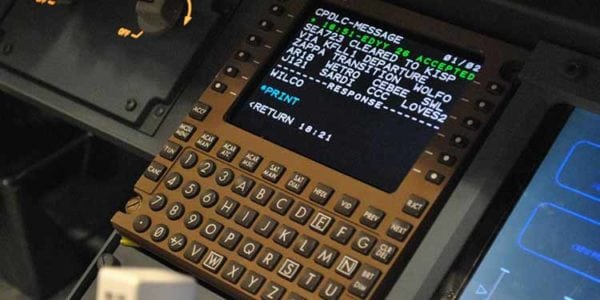
Data Comm on an airplane cockpit display. Photo courtesy of Harris Corp.
The FAA’s Data Comm, a controller-to-cockpit modernization program for domestic U.S. airspace, is now being used on 36,000 flights per week at 55 airports and has cleared a total of one million flights since its inception. Avionics caught up with Chris Collings, senior program manager for Harris Corp.’s network operations division, to discuss the latest progress with Data Comm.
Harris was originally awarded the FAA’s $331 million Data Communications Integrated Services (DCIS) contract in 2012 to enable the exchange of digital messaging between pilots and controllers. Five years later, deployment of Data Comm has been achieved at 55 total airports throughout the National Airspace System. On June 2, the 1,000,000th flight to use Data Comm, operated by Southwest Airlines, occurred on a trip from Minneapolis, Minnesota, to Denver, Colorado.
Currently there are 12 U.S. airlines participating in the Data Comm program, along with 38 international carriers. Business jets and military transport aircraft are also using the capability in domestic U.S. airspace, with an estimated 4,000 business jet Data Comm flights occurring in June 2017.
Basic equipage requirements for the use of DCIS includes a flight management system and a multi-purpose control display unit that is capable of providing an interface for Controller to Pilot Data Link Communications (CPDLC) messages. Aircraft also need a communications management unit, a cockpit voice recorder capable of recording data link communications and a very high frequency (VHF) transceiver featuring VHF Data Link Mode 2 capability. Aircraft using FANS 1/A for this capability in oceanic environments also need an ARINC 741 Level D compliant satellite communications system.
Collings said some of the biggest benefits being realized by operators using DCIS are receiving updated departure clearances when a hazardous weather event has occurred.
“We’ve seen a lot of usage when the FAA’s severe weather avoidance program requires planned or alternate routing at an airport to avoid hazardous weather,” Collings told Avionics. “During these weather events, we’ve seen major taxi delay savings by airplanes that receive the clearance versus airplanes that otherwise would have received their clearance by voice.”
As part of DCIS, the FAA and Harris also established an avionics equipage incentive assistance program for airlines, to help finance the cost of upgrading their aircraft to enable Data Comm capability. Thus far, 1,400 of the 3,000 targeted aircraft have participated in the program.
Next for the Data Comm program is to establish the use of CPDLC within en route airspace. Collings said Harris and the FAA have been working with operators over the past 18 months to prepare for the deployment of the use of CPDLC in en route airspace.
“We expect to achieve initial operational capability for the use of Data Comm in the en route airspace by October 2018,” said Collings, noting that timeline would be slightly ahead of the FAA’s targeted milestone of 2019.
The FAA has divided its en route deployment of Data Comm into two phases, with the first phase focusing on the delivery of initial en route services such as basic exchanges between controllers and pilots in high-altitude airspace. The second phase will be more advanced.
“It will also include more capable functionality such as re-routes, which is truly an evolutionary capability for the FAA. Where we expect to see the benefits in en route are the delivery of these re-route messages from ATC to the flight deck,” said Collings.